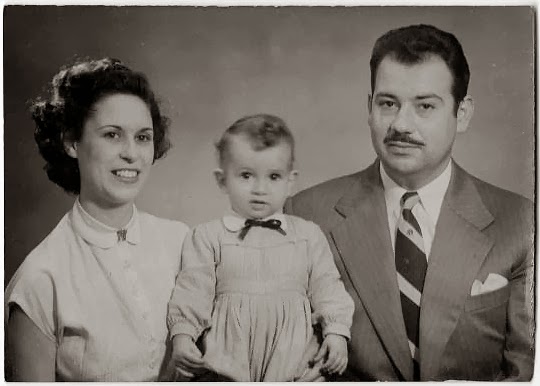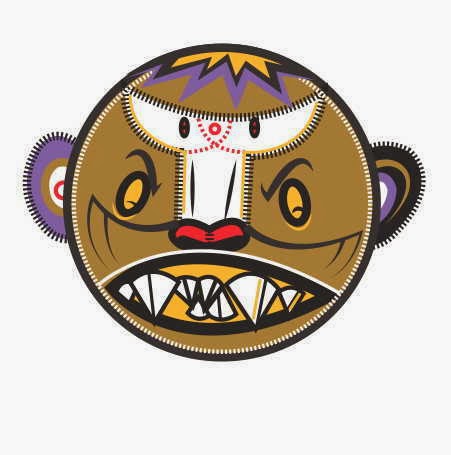 |
| A mãe, Maria, o Pai, António, e o filho, António Maria Anotações na foto: "Dezembro 1953/ Miúdo tremido/ Prova regeitada" |
por ANTÓNIO CERVEIRA PINTO
Um amigo enganou-se na data e resolveu enviar-me uma mensagem de parabéns no dia anterior ao aniversário. Como a saudação foi também enviada para uma lista de correio, aconteceu algo para mim inédito: sucessivos mensagens de felicitações antes do dia sagrado. Até a minha filha, que viveu em Madrid os últimos quinze anos, e parte amanhã para Bruxelas, me telefonou dando os parabéns, uma hora antes do dia 27, esquecendo-se que em Madrid se vive sessenta minutos à frente de Lisboa. Fartámo-nos de rir na conversa Skype sobre o tema.
Este episódio insólito levou-me a reparar numa circunstância ainda mais insólita: há décadas que comemoro o meu aniversário com oito horas de atraso sem nunca me ter dado conta disso. Nasci em Macau, junto às ruínas de São Paulo, a 27 de novembro de 1952, às duas e meia da tarde. Os pais eram lindos, e eu ainda sou ;) Ao acordar neste meu dia de anos vivi um sonho renitente. Tinha deixado o meu boné no vestiário de um grande edifício, onde entrava e de onde saía muita gente, e quando o quis recuperar, não apareceu. Havia centenas de bonés, e eu podia, na realidade, ter levado qualquer um, e havia-os de todas as cores e feitios, alguns novinhos em folha, outros com marcas caríssimas. Mas eu queria o meu boné. Tentava lembrar-me de todas as suas características, descrevendo-as às meninas e aos rapazes que atendiam as pessoas apressadas como eu. Mas nada, não aparecia. Acabei por acordar. Voltei ao sono e o mesmo sonho regressou. Circulavam então diante do vestiário empregados com carrinhos transportando todo o tipo de roupa, bonés incluídos, e até o meu robe de feltro branco! Mas o meu boné, nada...
A manhã nasceu gelada, meti-me no duche quente e organizei, como sempre faço, o dia que iria ter.
A Cândida deu-me um beijinho de parabéns. Decidimos que não iríamos almoçar fora, que eu prepararia um belo peixe assado acompanhado do espumante bruto da Cartuxa, 2009. Esprememos laranjas de inverno, azedas como eu gosto, torrámos pão, e preparámos o café. Corrijo: a Cândida preparou o pequeno almoço e trouxe o café para a mesa inundada de Sol, como quase sempre faz. Apesar do frio de rachar, o Deus da luz inundou a casa como sabe que adoro, sem cerimónias. Liguei o computador e a Cândida ofereceu-me, com os cuidados prévios do costume —que se não gostasse poderia trocar, que tinha o recibo, que..., que achava que eu iria gostar... do livro de Isabel Stilwell sobre uma das minhas heroínas: a Rainha Filipa de Lencastre, inglesa e mãe de uma geração de portugueses educados como raramente vimos na nossa História. Abracei-a e ganhei o dia naquele momento.
Antes de sairmos, já o meio dia ia bem alto, para comprar o peixe fresco, ressurgiu a pequena aflição sobre o frio lá fora. Não sei porquê, levara para o nosso apartamento no Porto todos os agasalhos de inverno. Calculei, mal, que passaria boa parte do tempo lá para o Norte, em vez de continuar as minhas rotinas pelo Sul. E o meu querido sobretudo felpudo do Adolfo Domínguez tinha-o deixado há meses em casa do Pedro, meu querido amigo do liceu D. Manuel II. Como nunca mais cumpri a promessa de o trazer até nossa casa para almoçarmos juntos, o castigo aí estava: fazia frio lá fora, e eu estava sem abrigo!
Haveria algum anorak no guarda roupa da garagem, ou foram todos para o Porto, perguntava-me a Cândida. Não sei, vou espreitar.
Dentro de uma protetora capa de PVC azul escuro lá estava um esplêndido e por estrear 'Outdoor Wear' herdado do meu pai, e de que não tinha já a menor lembrança. Desde que a minha mãe partiu, e o meu pai foi ter com ela, que a presença de ambos se foi tornando cada vez mais viva. Um leve sentimento de culpa perpassa por vezes estas memórias. Sinto-me hoje muito mais perto do pai do que quando este era vivo e com ele mantinha divergências ideológicas permanentes e ambos cultivávamos silêncios que soavam como tratados. Ele foi um militar íntegro, e viu tudo. Nunca vi ninguém suportar a dor como ele. Era evidente que seria eu, o filho mais velho, crítico, irrequieto, que dois dias antes discutira com ele por uma carta estúpida vinda da aldeia, quem ele veria pela última vez antes de ser entregue a uma médica galega aflita no Hospital Militar Principal, onde morreria uma hora de agonia depois.
A Patrícia, minha filha, deu-me, a mim e à Cândida, uma grande felicidade ao ter ganho, por mérito exclusivamente próprio, há pouco mais de um mês, um difícil concurso de acesso a um posto de trabalho numa grande empresa de consultoria em Bruxelas. A Cândida ofereceu-me um livro magnífico. E o meu pai protegeu-me do frio quando menos esperava.
Que dia!


